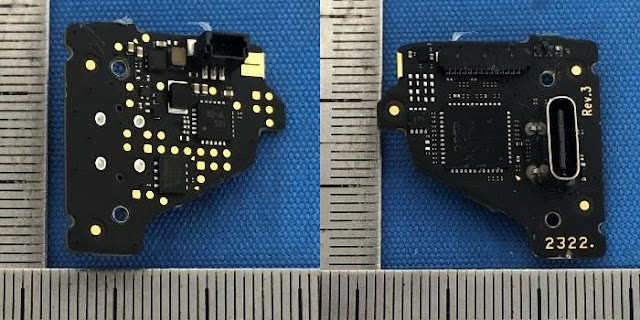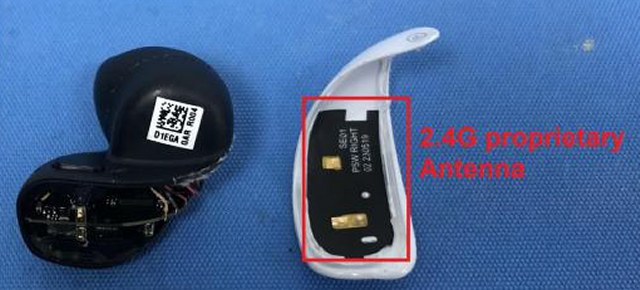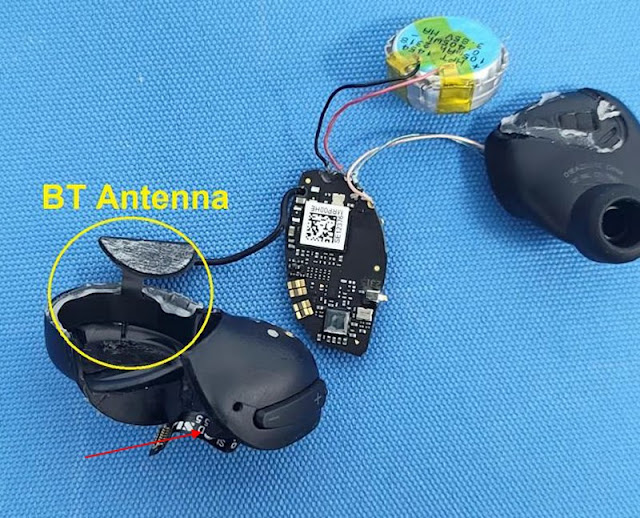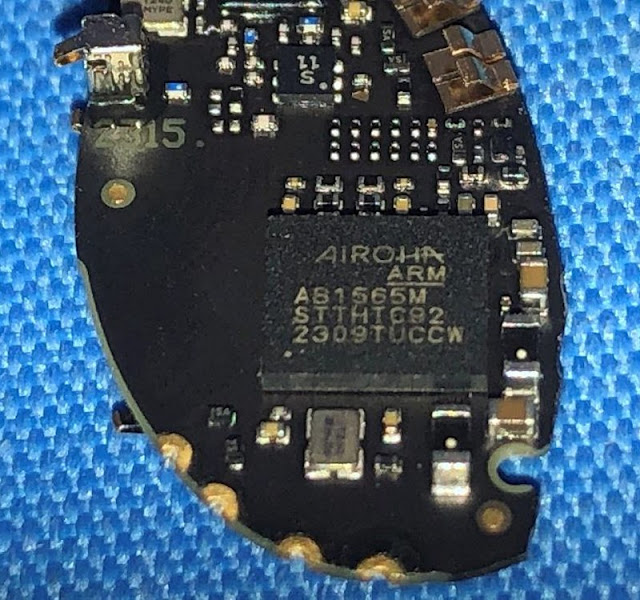The FCC internal documents for the PlayStation PULSE earbuds are finally available. Time to dive in and see what they reveal.
Starting off with the case, the exterior piece which holds the earbuds looks to be glued into place, so a spudger and force will be required to remove it.
- Case main PCB
- Status LED PCB
- Link button PCB
We can see the battery on the back of the case. The long wires connect the charging terminals to the main PCB. I do not see any magnets to align the earbuds, but difficult to tell from these photos. Moving to the battery next, the model number is 541963, but this was revealed in a previous certification. The battery is attached using a black adhesive strip, visible in the photo below.
The supplier is Springpower again, with a rating of 780mAh/3.0Wh at 3.85V.
Here we have the main PCB which is placed on the right side of the case. We can see the USB type-C port, the battery connector, and a controller chip. I do not see any resettable fuses on the board, so perhaps the battery protection circuit has them, or protection ICs.
While the full text on the controller chip is not visible, this is the NXP KL28, which is the K32 L2 Ultra low power MCU from NXP. The chip used here has 64KB for flash memory size, for comparison, the WF-1000XM5 uses a MCU with 128KB flash memory.
This is the link button PCB with the button in the middle of the left photo.
The LED PCB has 2 LEDs and not much else. I wonder if Sony could have used a flex PCB with the LEDs rather than the setup we see here. The flex PCB could then just slot into a connector on the main board.
The earbuds themselves do not have many teardown photos, and there are no photos of the driver or mics, or any of the details of the flex PCB. I hope we will see a 52Audio teardown but do not have high hopes.
The white earbud cover can be removed, this piece looks to be held on by glue around the edges. The wireless 2.4 Ghz antenna is right under the cover. There is no touch component to the antenna like in other Sony earbuds, instead Sony has opted for a physical buttons for volume control and pairing. The earbuds have 2 wireless antennas on the flex PCB, as seen in the photo below, Tx1 and Tx2. The antenna is a flex PCB.
This photo also provides some information about the battery placement and the Bluetooth antenna which surrounds the battery. So unless I am mistaken, it looks like we have a total of 3 antennas inside the earbuds.
Here is a closeup of the reverse sdte of the flex PCB antenna. Shame it was not removed for the teardown.
One shot shows the main PCB outside of the case but still connected to most of the components like the BT antenna, the battery, and the driver. The red arrow points to the flex PCB which I would assume has charging contacts, volume buttons, pairing button, and voice mics.
I say mics because Sony in their support for the earbuds, mentions microphones, so I guess there are 2, with both of these being MEMS mics on the flex PCB. This flex PCB is connected to the main board with a board to board connector.
We can see the coin cell battery here, along with its details. We already knew the capacity from previous certifications though, which revealed the battery to be from Springpower. The 1454 size is the same as Sony uses on the WF-1000XM5, which begs the question, why not just use this larger battery in the WF-1000XM5 as well? I think it might be a weight issue. If I had unlimited funds, I would try and transfer this larger capacity battery to the WF-1000XM5 to see what kind of improvements in battery life it would provide.
The main PCB has the main Bluetooth chip, along with some other connections like for the flex PCB, Bluetooth antenna, and the flex PCB antenna. Unlike other Sony earbuds, the Pulse explore use a black PCB rather than blue. Not sure why, but I do not think it makes a difference.
Finally we have a shot of the Bluetooth chip, Airoha AB1565M. In my original post, I had 4 options for the Bluetooth chip, and it appears it was the first one. I am wondering why Sony opted for an Airoha chip, rather than the Mediatek chips they use or their own CXD3277 found in the INZONE buds. There is a reason but no idea what it could be.
The AB1565 is LE Audio certified, but the earbuds do not have LC3 codec support, only SBC and AAC. Perhaps a firmware update will add LC3 in the future. The wireless connection for gaming uses some proprietary codec, I suspect similar to what the INZONE headsets use.
And with that, this concludes the FCC teardown analysis. If anyone spots anything in the photos, drop it in the comments.
If you wish to support the blog, grab a pair with the Amazon affiliate link below.
















Nice post. Maybe they didn't choose the INZONE chip because it doesn't support classical bluetooth and PlayStation is more mainstream? Glad to hear that this one also supports LC3, but I somehow doubt they will update it. The battery life doesn't make it very suitable for mobile use.
ReplyDeleteI would guess the wireless protocol for gaming is quite different from the INZONE Buds, since they market it as PlayStation Link, calling it lossless (I've not seen that claim for INZONE) and allow linking to multiple adapters.
As far as I have read this is the first Sony product from Audeze since being purchased, maybe explains why it differs so much from other Sony buds, PCB color and all.
As an owner of these, the INZONE Buds and the WF-1000XM5 I kind of appreciate the small differences making them stand out from each other and having distinct use cases.
/M
INZONE buds only support LC3, but no AAC or even SBC, but LC3 replaces SBC anyways.
Deleteregarding the protocol, I mean it uses something proprietary, like the inzone headsets (minus the inzone buds). The H7/9 both have a NXH3670 chip which is a proprietary 2.4 GHz wireless stream. It can support up to 2 Mbits/s according to the datasheet, but there is no mention of lossless in the document, so not sure this is lossless.
As for what Sony classifies as lossless, no idea, but I suspect it might be WLAN as some of the FCC documents have WLAN for testing. I'd have to look closer to see.
My guess is that PS Link is based on Wifi and not Bluetooth because the bitrate of Lossless High Res is probably too high for Bluetooth. But I couldn't find anything what PS Link really is anywhere so far, only marketing blurb.
DeleteE_D___B
Ah, I recall now seeing the teardown of InZone Buds here mentioning a bluetooth chip in the transmitter, which surprised me, I though all USB headsets were wifi due to latency, but in this case it would be LE Audio solving that then. (Be it LC3 or some custom codec for gaming and PC Spatial Audio). Interesting note about the 2 Mbps on the H9, Buds should be limited to 256 kbps then?
DeleteBluetooth can hardly carry anything lossless can it.
I'm really hoping the 1000XM6s will be Snapdragon Sound / wifi (caring more about stability than lossless though), but probably will take one generation more... /M